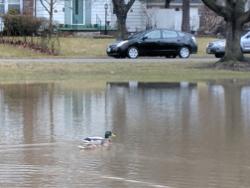 This week, a combination of 6 inches of rain in 36 hours, 12 inches of existing snow, sudden 60-degree weather, and still-frozen ground created record-breaking floods in my city. (For those on the metric system, that's 15.2 cm rain, 30.5 cm of snow, and 15.6 degrees C.)
This week, a combination of 6 inches of rain in 36 hours, 12 inches of existing snow, sudden 60-degree weather, and still-frozen ground created record-breaking floods in my city. (For those on the metric system, that's 15.2 cm rain, 30.5 cm of snow, and 15.6 degrees C.)
Complicating this for me personally is that fact that I live one block away from a river which crested 7.2 feet (2.2 m) above flood stage late Wednesday night. The water is receding now, and our street is open for traffic again.
So, it's been a fun week for the ducks, as you can see in the picture of the normally dry park across the street from my house. (The good news is for my family, the water coming in the basement is coming in at a rate a pump can keep up and it's clean ground water. A worse flood in 2016 prompted us to pack everything up in plastic bins.)
I live in a pretty close-knit neighborhood, and once my wife and I got everything squared away in our own home, we reached out to see who needed help with what. For a while Wednesday and Thursday it was a lot of us sloshing around in boots going around from house to house with hoses and groceries and (ideally) useful information.
This is what struck me during the crisis: accurate information was really hard to come by. I was constantly accessing the hydrograph page linked above, reading the news, and felt like I was getting pretty solid information. But my neighbors were relaying things like the river would rise three more feet (it did not), or the National Guard was planning to evacuate (they did not). And these are very intelligent people, too. What was happening?
A lot of this, I am sure, was stress-related anxiety. Water is great, but when it is showing up uninvited in places it is not supposed to be, people tend to freak out. So peoples' worries were coloring what they were reading and seeing on the news. Goodness knows I was hitting refresh on that hydrograph page about 50 billion times.
There was also the issue of recognizing and using canonical sources of information. If you didn't watch TV for weather and updates from the mayor, and were getting information from a friend of a friend on Facebook or just the neighborhood mailing list, then things were going to be skewed and possibly incorrect.
For a community, this is why we should always stress that lines of communication are always open and always well-known. Open source developer and user communities rarely face floods (though I am sure the stress and aggravation felt by kernel developers during the Spectre and Meltdown crises ranked right up there). But even on a day-to-day basis, folks are going to have questions or comments about the project and they need to know where to go.
This is not advocating one form of communication over another. Some communities hang out on IRC. Some on mailing lists. Others on website forums, or Slack, or whatever they have collectively decided to use. No stick with where everyone is at. But definitely make it crystal clear on your project's web, GitHub, or GitLab page that if people want to discuss your project, this is where they need to go.
Hopefully your community will never suffer through a crisis of any kind. But even so, knowing where the gathering places are will make it easier for people to come on board and join your community. And, if there is a crisis point, a definitive canonical place for discussion and information sharing will save a lot of time and effort in getting things back to normal.
Image by author. No ducks were harmed in the taking of this photo. Or photographers.
À propos de l'auteur
Brian Proffitt is Senior Manager, Community Outreach within Red Hat's Open Source Program Office, focusing on enablement, community metrics and foundation and trade organization relationships. Brian's experience with community management includes knowledge of community onboarding, community health and business alignment. Prior to joining Red Hat in 2013, he was a technology journalist with a focus on Linux and open source, and the author of 22 consumer technology books.
Parcourir par canal
Automatisation
Les dernières actualités en matière de plateforme d'automatisation qui couvre la technologie, les équipes et les environnements
Intelligence artificielle
Actualité sur les plateformes qui permettent aux clients d'exécuter des charges de travail d'IA sur tout type d'environnement
Services cloud
En savoir plus sur notre gamme de services cloud gérés
Sécurité
Les dernières actualités sur la façon dont nous réduisons les risques dans tous les environnements et technologies
Edge computing
Actualité sur les plateformes qui simplifient les opérations en périphérie
Infrastructure
Les dernières nouveautés sur la plateforme Linux d'entreprise leader au monde
Applications
À l’intérieur de nos solutions aux défis d’application les plus difficiles
Programmes originaux
Histoires passionnantes de créateurs et de leaders de technologies d'entreprise
Produits
- Red Hat Enterprise Linux
- Red Hat OpenShift
- Red Hat Ansible Automation Platform
- Services cloud
- Voir tous les produits
Outils
- Formation et certification
- Mon compte
- Ressources développeurs
- Assistance client
- Calculateur de valeur Red Hat
- Red Hat Ecosystem Catalog
- Rechercher un partenaire
Essayer, acheter et vendre
Communication
- Contacter le service commercial
- Contactez notre service clientèle
- Contacter le service de formation
- Réseaux sociaux
À propos de Red Hat
Premier éditeur mondial de solutions Open Source pour les entreprises, nous fournissons des technologies Linux, cloud, de conteneurs et Kubernetes. Nous proposons des solutions stables qui aident les entreprises à jongler avec les divers environnements et plateformes, du cœur du datacenter à la périphérie du réseau.
Sélectionner une langue
Red Hat legal and privacy links
- À propos de Red Hat
- Carrières
- Événements
- Bureaux
- Contacter Red Hat
- Lire le blog Red Hat
- Diversité, équité et inclusion
- Cool Stuff Store
- Red Hat Summit

